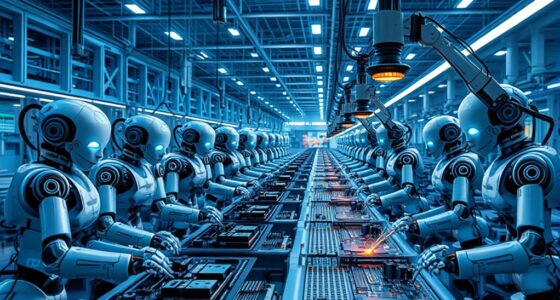Despite over 78,000 tech layoffs in early 2025 driven by rapid AI adoption, new opportunities are emerging in specialized areas like AI engineering, infrastructure, and strategic problem-solving. If you focus on developing future-proof skills and adapt to the evolving landscape, you’ll find pathways into roles that aren’t being automated. Staying ahead means embracing change—continue exploring how you can position yourself for these emerging roles and thrive in the shifting industry.
Key Takeaways
- Many new jobs are emerging in AI engineering, infrastructure, and support roles due to increased AI adoption.
- Transition opportunities exist for workers willing to acquire future-proof skills like strategic thinking and problem-solving.
- Companies are creating new roles focused on automation management and AI ethics to support AI integration.
- Some firms are investing in workforce reskilling programs to fill emerging positions in technology and AI-related fields.
- Despite layoffs, the demand for specialized AI expertise is driving growth in niche tech sectors and innovative startups.

Have you noticed the surge in layoffs across the tech industry despite widespread AI adoption? It’s a stark reality in 2025, with nearly 78,000 tech jobs lost from January to early June alone due to AI. You might be wondering how so many jobs are disappearing even as AI becomes more integrated into daily operations. The answer lies in the rapid pace at which companies are adopting AI—about 90% of US firms have already embraced these technologies, with 30% actively replacing workers with AI tools. Many are automating tasks rather than augmenting human roles, which accelerates job cuts. Major players like Amazon and Microsoft have made significant layoffs directly tied to AI, reflecting a broader industry trend. On average, about 507 tech workers lose their jobs daily this year to automation, a number that highlights the scale of displacement. Nearly 78,000 tech jobs have been lost so far this year, underscoring the significant impact AI-driven automation is having on employment.
While AI aims to increase efficiency, it’s also reshaping how companies allocate resources. Instead of investing in human talent, many firms are redirecting budgets toward AI development and infrastructure. This shift leaves traditional roles vulnerable, especially as many skills become obsolete in the face of automation. If you work in a sector being targeted for AI integration, you might feel the pressure to upskill quickly. But the challenge is that new job creation isn’t keeping pace with layoffs. Instead of new roles emerging, companies are focusing on restructuring and optimizing existing workflows, which often results in redundancies. This transformation is making the job landscape more uncertain, as the industry shifts toward becoming leaner and more efficient. Additionally, this trend emphasizes the importance of workforce adaptability in navigating the evolving employment landscape.
AI-driven resource shifts threaten traditional roles, with automation reshaping workflows and slowing new job creation, increasing industry uncertainty.
The impact on workers is profound. Layoffs often come with psychological stress and a sense of instability about the future. Many employees find their skills no longer match the demands of an AI-driven workplace, creating a widening skills gap. As AI takes over specific tasks, workers face the uncomfortable reality of job obsolescence and limited opportunities for transition within their current fields. The broader economic effects can’t be ignored either, as reduced consumer spending from layoffs can ripple through the economy.
Despite the bleak outlook, there are emerging opportunities if you’re willing to adapt. Developing skills related to AI—such as engineering, infrastructure, or AI support—becomes essential for staying relevant. Strategic thinking and problem-solving skills are also in demand, as companies look for talent that can work alongside AI rather than be replaced by it. The key for you, then, is to focus on acquiring these future-proof skills, understanding that the landscape is shifting rapidly. While layoffs are high, so too are the chances for those willing to learn and pivot into new roles within this evolving tech industry.
Frequently Asked Questions
How Are AI Layoffs Affecting Global Economies?
You see AI layoffs impacting global economies by causing significant job losses, especially in tech sectors across the US, Europe, and Asia. These layoffs lead to market volatility and regional employment shifts. However, you also notice companies investing heavily in AI, creating new roles and emphasizing skill development. Overall, economies adapt by fostering innovation and supporting emerging AI industries, shaping a complex, evolving job landscape worldwide.
Which Industries Are Still Hiring AI Talent?
You’ll find that industries like technology, insurance, non-profits, marketing, and legal services are still hiring AI talent. Tech remains the biggest employer, especially in states like California and New York. Insurance and non-profits are rapidly expanding their AI teams, focusing on risk analysis and social goals. Marketing and legal sectors also grow, using AI for consumer insights and legal automation. Overall, these industries are actively creating new AI roles despite layoffs elsewhere.
What Skills Are Most in Demand Amid AI Layoffs?
You need to know that data literacy and systems thinking are the most in-demand skills right now. Nearly 60% of new AI roles require advanced data analysis and interpretation. You should focus on developing skills like critical reasoning, ethics, and cybersecurity. These areas are essential for emerging jobs in AI training, integration, and governance, especially as industries like healthcare and green tech see rapid growth and new opportunities.
How Can Displaced Workers Transition Into New Roles?
You can shift into new roles by focusing on developing in-demand skills like AI upskilling, data analysis, cybersecurity, and creativity. Take advantage of online courses, attend industry workshops, and join professional networks to stay informed and connected. Explore emerging industries such as healthcare tech, sustainability, and e-commerce. Look for government retraining programs and community support to guide your career shift, ensuring you’re prepared for the evolving job market.
Are Government Policies Helping Mitigate Ai-Related Job Losses?
You’re wondering if government policies are helping with AI-related job losses. They are, by encouraging retraining programs, offering tax credits, and promoting upskilling to help workers adapt. Policies also focus on maintaining healthcare through portable benefits, ensuring economic stability. Governments work with businesses and AI companies to develop strategies, create new job opportunities, and prepare workers for the changing job landscape, making the passage smoother for those affected.
Conclusion
So, even with AI layoffs soaring like a rocket to the moon, don’t lose hope. New jobs are out there, waiting like hidden treasures in a vast digital jungle. It might seem like the job market’s a rollercoaster with more drops than climbs, but opportunities are still blooming. Keep your skills sharp and eyes peeled—you’re more than capable of riding this wild ride and landing in a place where you’ll thrive.









